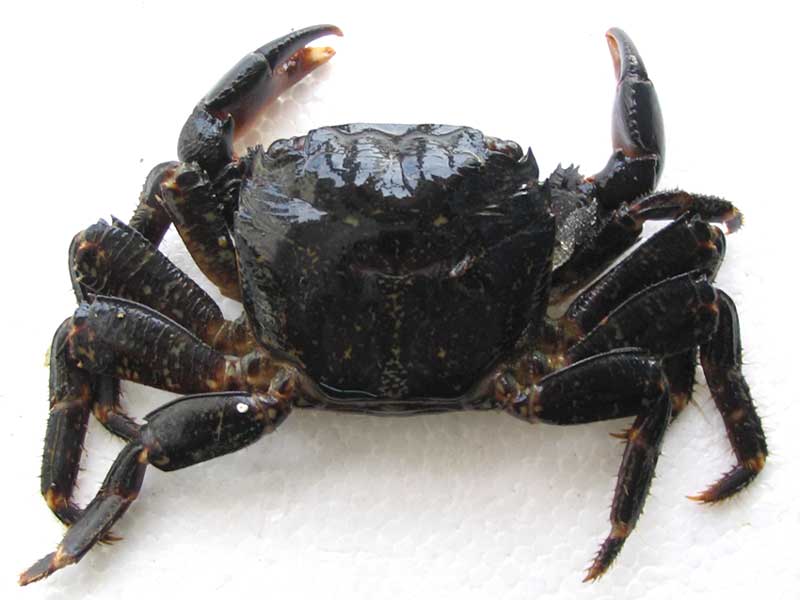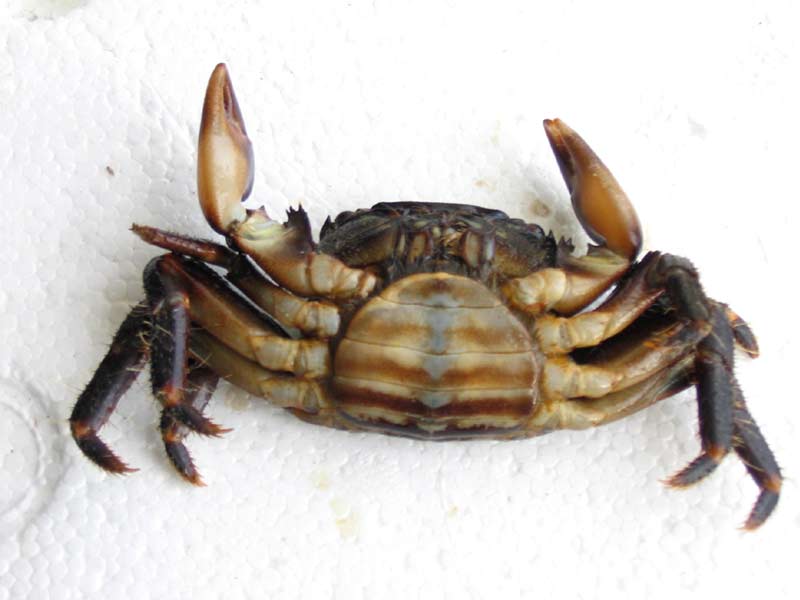Marbled rock crab (Pachygrapsus marmoratus)
Distribution data supplied by the Ocean Biodiversity Information System (OBIS). To interrogate UK data visit the NBN Atlas.Map Help
| Researched by | Rose Edwards | Refereed by | Admin |
| Authority | (Fabricius, 1787) | ||
| Other common names | - | Synonyms | - |
Summary
Description
Pachygrapsus marmoratus has a shell (carapace) length of up to 3.6 cm. It is violet brown to almost black in colour with a marbled pattern of yellowish brown. The carapace is almost square and slightly broader than long, with distinct diagonal ridges visible. It has a convex shape both longitudinally and transversely. The front edge between the eyes is particularly straight and wide with three pointed teeth on each side. The chelipeds are large and slightly unequal in size. The male chelipeds are more robust than those of the female. The closest segment to the carapace (merus) on the walking legs are prominent, and the last segment (dactyl) has small spines.
Recorded distribution in Britain and Ireland
Usually a Mediterranean species but it was recorded recently in the Teign Estuary, Devon and the Fal Estuary, Cornwall.Global distribution
Recorded in the north eastern Atlantic from north eastern Brittany (France) southwards to Canary Islands. This is an essentially Mediterranean and Black Sea species.Habitat
Pachygrapsus marmoratus occurs on rocks in the upper to middle shore, in the crevices of breakwaters, pier piles or similar habitats.Depth range
-Identifying features
- Carapace length 2.2-3.6 cm.
- Violet brown to almost black colour carapace with lighter coloured limbs.
- Carapace almost square in shape.
Additional information
This species can be distinguished from the two other species of Pachygrapsus occurring in the Mediterranean by the three teeth on the front of the carapace antero-lateral margins. It is very quick moving and exceedingly difficult to catch on account of its singular ability to slip into the narrowest of crevices.
Listed by
- none -
Bibliography
Crothers, J. & Crothers, M., 1988. A key to the crabs and crab-like animals of British inshore waters. Somerset, England: Field Studies Council. [AIDGAP guide, no. 155.]
Hayward, P., Nelson-Smith, T. & Shields, C. 1996. Collins pocket guide. Sea shore of Britain and northern Europe. London: HarperCollins.
Hayward, P.J. & Ryland, J.S. 1994. The marine fauna of the British Isles and north-west Europe. Volume 1. Introduction and Protozoans to Arthropods. Oxford: Clarendon Press.
Howson, C.M. & Picton, B.E., 1997. The species directory of the marine fauna and flora of the British Isles and surrounding seas. Belfast: Ulster Museum. [Ulster Museum publication, no. 276.]
Ingle, R., 1997. Crayfishes, lobsters and crabs of Europe. An illustrated guide to common and traded species. London: Chapman and Hall.
Ingle, R.W., 1980. British Crabs. Oxford: British Museum (Natural History), Oxford University Press.
JNCC (Joint Nature Conservation Committee), 1999. Marine Environment Resource Mapping And Information Database (MERMAID): Marine Nature Conservation Review Survey Database. [on-line] http://www.jncc.gov.uk/mermaid
Datasets
NBN (National Biodiversity Network) Atlas. Available from: https://www.nbnatlas.org.
OBIS (Ocean Biodiversity Information System), 2025. Global map of species distribution using gridded data. Available from: Ocean Biogeographic Information System. www.iobis.org. Accessed: 2025-07-05
Citation
This review can be cited as:
Last Updated: 05/04/2005




